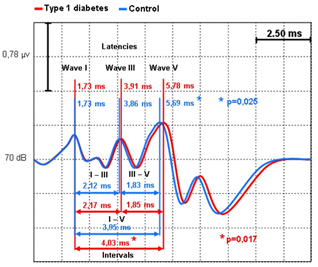
Synonyms: Brain stem evoked response audiometry, Auditory brain stem response, ABR audiometry, BAER (Brainstem auditory evoked response audiometry).
Definition: Bera is an objective way of eliciting brain stem potentials in response to audiological click stimuli. These waves are recorded by electrodes placed over the scalp. This investigation was first described by Jewett and Williston in 1971.
Even though BERA provides information regarding auditory function and sensitivity, it is not a substitute for other methods of audiological evaluation. It should be always viewed in conjunction with other audiological investigations.
Procedure: The stimulus either in the form of click or tone pip is transmitted to the ear via a transducer placed in the insert ear phone or head phone. The wave froms of impulses generated at the level of brain stem are recorded by the placement of electrodes over the scalp.
Electrode placement: Since the electrodes should be placed over the head, the hair must be oil free. The patient should be instructed to have shampoo bath before coming for investigation. The standard electrode configuration for BERA involves placing a non inverting electrode over the vertex of the head, and inverting electrodes placed over the ear lobe or mastoid prominence. One more earthing electrode is placed over the forehead. This earthing electrode is important for proper functioning of preamplifier.
 Since the potentials recorded are in far field, well displaced from the site of impulse generation, the wave forms recorded are very weak and they need to be amplified. This amplification is achieved by improving the signal : noise ratio.
Since the potentials recorded are in far field, well displaced from the site of impulse generation, the wave forms recorded are very weak and they need to be amplified. This amplification is achieved by improving the signal : noise ratio.
How to improve signal to noise ratio: Three parallel approaches are designed to achieve this goal.
Filtering: This is employed to reduce the recording bandwidth so that only the important components of the siganal generated are recorded.
Repeated stimulation: This is done with synchronous time domain averaging to increase the amplitude of the components of the signal. In real time situations these two can be achieved by connecting the recording electrodes to a preamplifier, with appropriate filter settings.
Polarity alteration: By altering the polarity of impuses recorded, the artifacts are cancelled making the brain stem waves stand out.
In auditory brain stem evoked response audiometry, the impulses are generated by the brain stem. These impulses when recorded contains a series of peaks and troughs. The positive peaks (vortex positive) are referred to by the Roman numerals I - VII.
These peaks are considered to originate from the following anatomical sites:
1. Cochlear nerves - waves I and II
2. Cochlear nucleus - wave III
3. Superior olivary complex - wave IV
4. Nulclei of lateral lemniscus - wave V
5. Inferior colliculus - waves VI and VII
These peaks occur in most readable form in response to click stimuli over a period of 1 - 10 milliseconds after the stimulus in normal hearing adults.
BERA is resistant to the effects of sleep, sedation, sleep and anesthesia. Its threshold has been found to be within 10dB as elicited by conventional audiometry.
1. It is an effective screening tool for evaluating cases of deafness due to retrocochlear pathology i.e. (Acoustic schwannoma). An abnormal BERA is an indication for MRI scan.
2. Used in screening newborns for deafness
3. Used for intraoperative monitoring of central and peripheral nervous system
4. Monitoting patients in intensive care units
5. Diagnosing suspected demyelinated disorders
BERA findings suggestive of retrocochlear pathology:
1. Latency differences between interaural wave 5 (prolonged in cases of retrocochlear pathology)
2. Waves I - V interaural latency differences - prolonged
3. Absolute latency of wave V - prolonged
4. Absence of brain stem response in the affected ear
BERA has 90% sensitivity and 80% specificity in identifying cases of acoustic schwannoma. The sensitivity
increases in proportion to the size of the tumor.
Criteria for screening newborn babies using BERA:
1. Parental concern about hearing levels in their child
2. Family history of hearing loss
3. Pre and post natal infections
4. Low birth weight babies
5. Hyperbilirubinemia
6. Cranio facial deformities
7. Head injury
8. Persistent otitis media
9. Exposure to ototoxic drugs